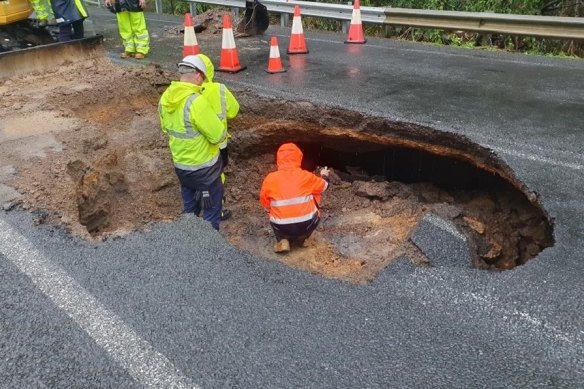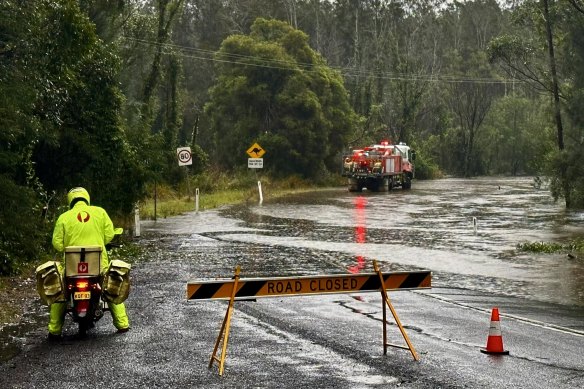This was published 7 months ago
The most disaster-prone council in NSW says it has run out of cash
By Catherine Naylor and Nigel Gladstone
The most disaster-prone council in NSW says it has run out of available cash and cannot afford for another calamity to strike as it pushes to increase rates for home owners by up to 12 per cent.
At an extraordinary council meeting last week, new deputy mayor Peter Wilkins said a report outlining Shoalhaven council’s dire financial position had “put a gun to the head of this current council” when it came to a rate increase.

Council workers assess the damage to The Wool Road, near Jervis Bay, from a pothole that opened up in June.
“Highest-order hospital pass – that’s what we’ve been given by the previous council,” Wilkins said.
“If you’d gone to the electorate seven weeks ago and said, ‘Geez, within 30 days of being in council we’re going to put the rates up 8, 12 … per cent,’ we would have been treated as though we had the plague. We would have been laughed out of town.”
Regional councils have borne the brunt of natural disasters such as bushfires, storms and floods over the past five financial years, figures show, with Shoalhaven and neighbouring Wingecarribee Shire recording 14 disasters each, on top of the pandemic – more than any other council in the state.
The disasters have wreaked havoc with council assets, especially roads, and have put significant pressure on a sector advocates say is already struggling thanks in part to cost-shifting from state and federal government and restrictions on rate increases.
Flood-prone Hawkesbury was the most unlucky council in Sydney, recording 10 disasters, along with the Central Coast. Lismore, devastated by record-breaking floods in 2022, also suffered through 10.
The emergencies that hit the Shoalhaven include the Black Summer bushfires that burnt almost 70 per cent of the area, and more than a dozen storms that washed away roads and caused landslides, including 38 around Kangaroo Valley in 2022. Work to repair those landslips has recently been completed.
The most recent disaster was a severe storm with torrential rain in June, which caused a giant pothole to appear in a major arterial route near Jervis Bay, disrupting travel for thousands of people. It took months to repair.
The NSW government has issued 85 natural disaster declarations since 2019-20. These allow councils to seek emergency state funding for repairs but Shoalhaven council chief executive Robyn Stevens said the council also had to chip in about $600,000 each time.
“If [another] natural disaster were to occur, council would not have the available cash to respond,” Stevens said in her report to councillors before last week’s meeting, noting cash reserves had fallen from $19 million five years ago to zero in June.
Shoalhaven’s natural disasters
- Black Summer bushfires, from August 2019
- Storms and floods, January 2020
- Storm and flood, July 2020
- Storm and flood, August 2020
- Storm and flood, October 2020
- Storms and floods, March 2021
- Storms and floods, May 2021
- Severe weather and flooding, November 2021
- Severe weather and flooding, February 2022
- Severe weather and flooding, June 2022
- Flooding, September 2022
- Severe weather and flooding, November 2023
- East Coast flooding April 2024
- Severe weather, June 2024
Disaster expert Andrew Gissing said councils and governments needed to do more to mitigate against natural disasters before they occurred, to lower the cost of responding to them. He said council areas with lower populations and higher disaster risk were in the worst situation.
“Where councils are struggling to pay for infrastructure or repairs, it will end up being the state or federal government that ultimately will wear the burden to fix that infrastructure and provide relief payments to households,” Gissing, who heads Natural Hazards Research Australia, said.
Back in the Shoalhaven, Stevens said council had lost almost $15 million to disasters since 2019, including through subsidies and fee waivers related to the pandemic, and faced a budget black hole of up to $35 million that could only be addressed through a special rate variation.

Woollamia road, near Huskisson, after a severe storm hit the Shoalhaven on June 6.
Last week, she called on councillors to put the option of an 8 or 12 per cent rate rise to the community for feedback, which they agreed to do. The previous council refused to support a staff push for a 32 per cent rate rise in January that would have restored the council’s finances.
Resident Denise Kemp told the meeting the council should not lean further on ratepayers, who were already struggling with the cost of living, and should cut its staff count instead.
Shoalhaven had the eighth-worst financial performance in the state in 2022-23, according to figures from the Office of Local Government, recording a net operating deficit of more than $18 million.
MidCoast Council, near Taree, recorded the largest deficit of $45 million. It has been hit by 10 disasters in the past five years. The best financial performer was The Hills Shire Council in north-west Sydney, which finished 2022-23 with a $51 million surplus despite seven disasters.
Overall, 43 of 128 councils recorded a deficit, and eight of the bottom 10 were in regional NSW. The average result across the state was a $1.8 million surplus.
Get to the heart of what’s happening with climate change and the environment. Sign up for our fortnightly Environment newsletter.